U.S.
 Business Insider UK 11 hours ago
Business Insider UK 11 hours ago
The Philippine container ship that crashed into a US guided-missile destroyer may be liable for almost $2 billion
 Business Insider UK 11 hours ago
Business Insider UK 11 hours ago 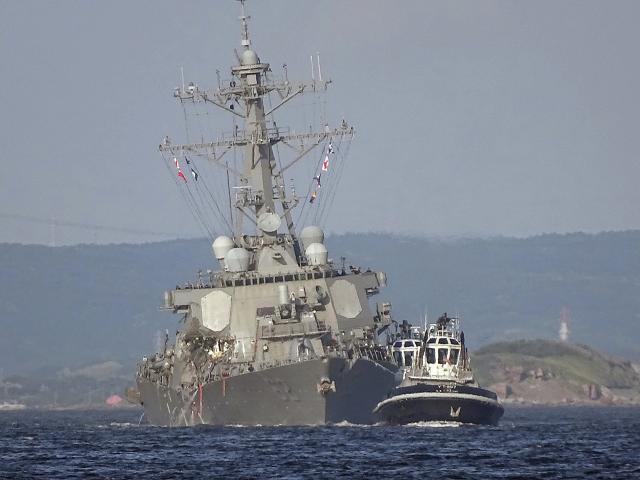 Associated Press/Eugene Hoshiko
Associated Press/Eugene Hoshiko
The USS Fitzgerald and the Philippine-flagged container ship MV ACX Crystal collided early in the morning on June 16.
The port bow of the containership, particularly its bulbous bow and its port anchor, came into contact with the starboard side of the destroyer opening three compartments to the sea and heavily damaging the deck structure aft of the bridge above the main deck.
The destroyer will require extensive and costly repairs over many months and tragically seven sailors were lost and three, including the commanding officer, were injured.
The containership suffered damage to her bow and port side forward. This is relatively minor hull damage and should result in modest costs or repair and delay or detention damage.
On the other hand, the Fitzgerald has suffered substantial physical damage. Its hull is damaged and perhaps warped or the keel broken. The bow of ACX Crystal struck the near the starboard bridge of the Fitzgerald causing extensive and expensive damage to electronic and communications gear located in this area. The cost of a replacement for the 21 year old DDG would be nearly $2 billion.
Repair costs may be less but probably would total hundreds of millions of dollars for hull damages alone. Detention damages might exceed the costs of physical repairs. Also, the estates of the seven dead sailors may seek to recover all their losses from ACX Crystal, and the surviving crew members can recover for loss of personal property and injuries.
The two ships would have to resolve issues of their liability, damages, and contribution under the concept of allocation of fault established by the US Supreme Court in Reliable Transfer in 1975.
Unlike the nearly complete lack of comment from US Navy sources, Japanese authorities recognize the price of losing the Fitzgerald from the defense of the Indo-Asian area.
On multiple occasions, the Fitzgerald was deployed to the sea around Japan and other areas in response to North Korean ballistic missiles, and it has participated in numerous Japan-US joint training exercises and drills. At the end of April, the ship participated in a training exercise for ballistic missile response with a Japanese Maritime Self Defense Forces Aegis destroyer in the Sea of Japan. At the beginning of June, it participated in a joint training exercise with the Maritime and Air Self-Defense Forces in the area stretching between the Sea of Japan and the waters east of Okinawa.
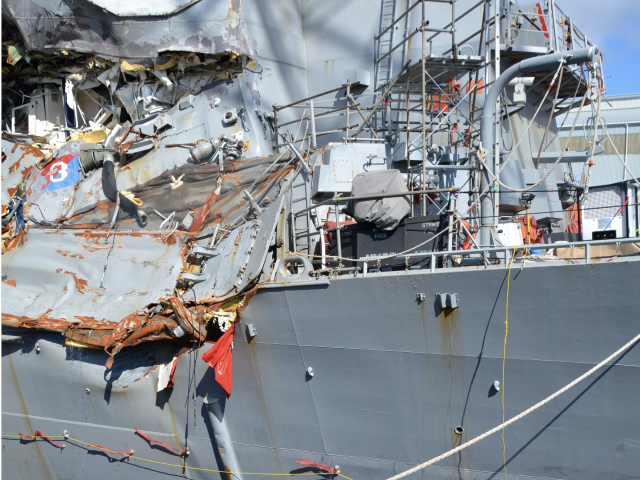 US Navy Photo
US Navy Photo
“The US Navy’s best ships in terms of defending Japan, maintaining stability of the situation in Asia, and the US global strategy are deployed to the Yokosuka base,” said Yoji Koda, a former commander in chief of the Self-Defense Fleet. “The Fitzgerald is of great value to the United States as a main force of the 7th Fleet tasked with those missions.”
Diplomatic analyst Yukio Okamoto said of the accident, “US Aegis destroyers are moving around Japan like that on a daily basis. The United States is demonstrating to surrounding countries that it is committed to defending Japan.” The loss of the Fitzgerald, its advanced defensive weapons systems and its 30 Tomahawk missiles is particularly painful at this time.
Former MSDF Chief of Staff Tomohisa Takei suggested that “the loss of the Fitzgerald seems to be a blow to the US Navy as it is highly possible that defenses in the South China Sea [where China is militarizing artificial islands] will become weak.” The US Navy has not yet announced plans to replace Fitzgerald while the ship is being repaired.
Now, almost a month after the casualty, the public has seen few details about the navigational situation except for the electronic navigation track of ACX Crystal that was transmitted ashore contemporaneously. Various versions have been made public and they provide some clues as to what may have happened that early morning long before first light in the crowded waters leading to one of the world’s largest and most important ports, Tokyo Bay.
Reuters also published an account of the report allegedly submitted by the Master of ACX Crystal to that ship’s owners.
Multiple investigations are being conducted by the US, Japan, and the Republic of the Philippines. Litigation is probable, if not inevitable. The factual record of these investigations, even if not conclusive or admissible at trial, will be crucial in developing the facts and thus the responsibility and causes of the collision. As every navigator and most admiralty lawyer knows few collisions are sole fault and most are the result of a synergy of errors (human and mechanical) that contribute to the damage and losses.
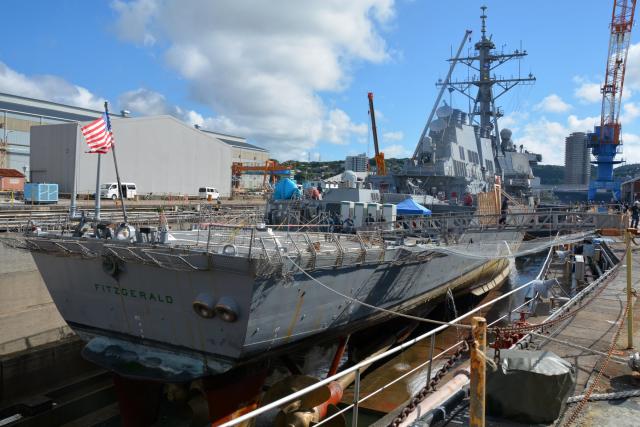 US Navy Photo
US Navy Photo
While the precise time of the casualty remains in dispute between the two vessels and while we know nothing about the navigational details and even location of Fitzgerald, we are able to deduce that at the time of the collision, the ships were operating at a location nearly 11 nautical miles due west of the To Shima more than 50 nautical miles south of Tokyo Bay.
The available electronic data of the track of ACX Crystal suggests that the collision occurred almost due west of the northernmost point of Toshima (34.5222 deg North, 139.072 deg. East) if the collision occurred at about 0130 as the containership contends. If, however, the collision occurred about 0220-0230 as the US Navy initially contended, then the site would be slightly to the northwest. The 50-60 minute time gap could make all the difference in determining the causal fault resulting in the casualty.
If the collision occurred at 0130, the containership was bound for a container pier near Tokyo. The ACX Crystal had been steaming east (course approximately 090) at about 20 knots from Nagoya when, 15 miles west of Toshima, she turned slightly to port altering to a course northeast (088 degrees) which would have taken it between Oshima to the north and Toshima to the south. ACX Crystal continued that course for the next four nautical miles during approximately 12 minutes before reaching a point 11 nautical miles west of the northwest corner of Toshima. That appears to be the location of ACX Crystal’s collision with Fitzgerald.
Then, ACX Crystal altered course, turning hard starboard to nearly a due South heading and after one nautical mile she then turned to port heading east of south for approximately one nautical mile before changing course to a northeast for approximately seven nautical miles heading between Toshima and Oshima before she reversed course and headed back to a point nearly due north and slightly to the west of the collision site.
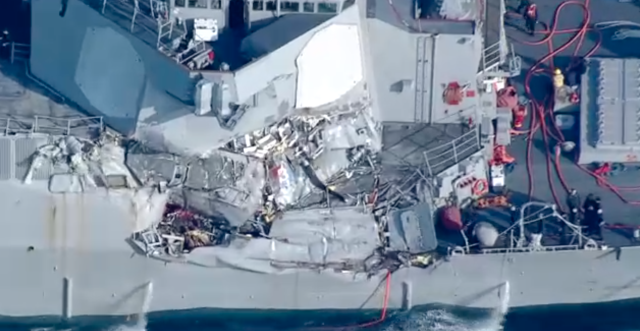 NHK Newsweb
NHK Newsweb
From the limited damage patterns visible in post-casualty photos of the forward starboard side above water of Fitzgerald and the port bow of ACX Crystal may be able to draw some conclusions from the impact damage. A US Navy spokesman described the below water damage to the hull of the Fitzgerald as 12x17 feet, which allowed water to enter two berthing (sleeping) compartments and a machinery space.
When photos of the underwater damage are made available, experts will be able to calculate the angle of blow at the time of collision. The scrapings and impact damage will be helpful in allowing experts to determine the navigation of the ships at the critical final moments. This information is consistent with the damage to both ships seen above water in the photographs that were released as early as the day of the collision.
The impact from the 29,000 deadweight ton ACX Crystal contacting the 10,000 ton displacement destroyer, Fitzgerald, resulted in limited distribution of “strain energy” throughout the smaller ship and plastic deformation of the destroyer’s hull. The initial post casualty photos of Fitzgerald show deformation of the hull not just at the point of impact and flooding but throughout, which are especially visible in the warped hull and twisted mainmast. The crew on the bridge of ACX Crystal may not have perceived the impact of their ship’s distant bow with the destroyer.
If, however, the steel-on-steel collision impact generated sparks, as commonly occurs during collision, the bridge watch should have seen the “shower of sparks." In any event, ACX Crystal failed to stand by and render assistance to the Fitzgerald as required by law. This serious failure could be proof of inattention by ACX Crystal’s bridge watch and look outs or an unusual attempt to “runaway” but the ship apparently returned to Fitzpatrick about an hour later.
Until the details of the navigation of Fitzgerald are made public it is impossible to reach final conclusions as to the faults and causes of the casualty. The limited information currently available strongly suggests that, like most cases involving collisions between two surface vessels, this will be a both-to-blame collision and that legal liability will be allocated between the two ships in proportion to their causative fault.
 US Navy Photo
US Navy Photo
The US will not, and need not, consider the doctrine of Limitation of Liability since the post-casualty value of its vessel exceeds the claims which may be asserted against it. It is too early to determine if ACX Crystal will be entitled to limitation of liability. Certainly, the claims asserted against the containership will exceed its post-casualty value, the basic limitation formula under US law. To establish entitlement to Limitation of Liability under the 1851 Federal Statute, the owners or bareboat charterers of the containership must prove that the cause or causes of the casualty were “beyond the privity and knowledge” of the owners.
Stated differently, pure navigational errors of a competent crew would allow the ship to limit its losses to the post-casualty value of the vessel. But they would be liable without limitation if the evidence shows that the owners (shore side management) knew or should have known of the unseaworthy conditions that contributed to the casualty and they must establish exercise of due diligence to ensure the seaworthiness of the vessel.
Because of the great disparity between the apparent claims of the two vessels, ACX Crystal may not wish to bring an action against the US even if it could. The containership, however, may wish to commence a limitation of liability proceeding in an effort to seek to limit its exposure to the anticipated massive claims of the US, the estates and the surviving crew members.
Essentially, a defensive action to bring all claims into a concurcus (a single forum), a limitation proceeding allows a ship owner to submit to jurisdiction and to attempt to gain exoneration or limitation of liability. US courts have a well-established and favorable proceeding available to all shipowners and bareboat charterers.
Seeking recovery from the United States as plaintiff, however, maybe procedurally impossible. An initial jurisdictional problem is that ACX Crystal flies the flag of the Republic of the Philippines and is owned by a Philippine corporation. Claims against the US for damage caused by warships, such as the Fitzgerald, are governed by the Public Vessels Act, which provides a limited waiver of sovereign immunity. A foreign ship owner only may sue the US for damage done by a US public vessel where a foreign ship owner can establish that its nation would allow American citizens to sue it for damage caused by its public vessels to a US flag vessel. The US is unlikely to agree to litigate this dispute in foreign courts.
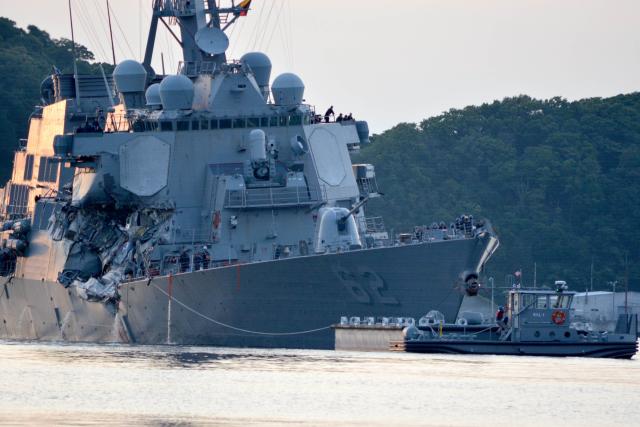 Wikimedia Commons
Wikimedia Commons
As previously mentioned, ACX Crystal interests may be reluctant to commence an action against the US for fear that unless it they are exonerated they will owe a substantial judgment to the US. The US Supreme Court has held that there is no reciprocity between the Republic of the Philippines and the United States in 1976. In United States v. United Continental Tuna, 425 US 164 (1976), where a commercial fishing boat, beneficially owned mostly by Americans through a Philippines corporation, had been sunk as the result of a collision with the destroyer USS Parsons.
The decision, written by Justice Thurgood Marshall, reversed the Ninth Circuit and held that the clear language of the Public Vessels Act required showing of reciprocity even if there was no such requirement in the Suits in Admiralty Act.
Here, the estates of the seven dead sailors and the surviving crewmembers can bring an action against the owners of ACX Crystal for their damages even though they are precluded presently from bring suit directly against the US for those damages under the Feres doctrine. Feres v. United States generally bars service members’ against the US for injuries sustained on active duty.
The Feres case was decided under the Federal Tort Claims Act on grounds specific to that statute which are inapplicable in admiralty law. There has been criticism of the Feres doctrine particularly by the late Justice Scalia. If ACX Crystal were found liable to the crew of Fitzgerald, the US may have to pay contribution to the container ship’s owner.
There are many open factual issues and legal issues but this major casualty will present lengthy, complicated, and expensive problems.
Lawrence Brennan is a former US Navy Captain, an adjunct professor of law at Fordham Law School, and an expert on maritime law.
See Also:

No comments:
Post a Comment